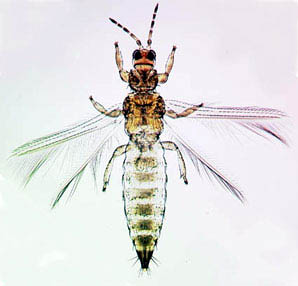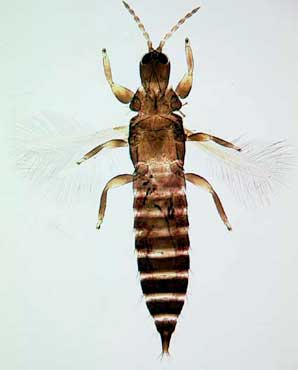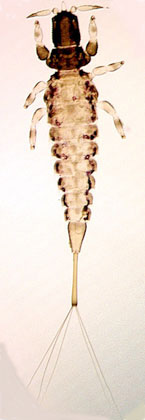
Thysanoptera [Thrips]
More than 5850 species of thrips are currently recognised from around the world. Their names and original authors, together with the formal classification of the insect order Thysanoptera, can be found at Thysanoptera (Thrips) of the World - a checklist.
Species of the order Thysanoptera are remarkable amongst insects, for several reasons.
Adults and larvae have asymmetrical mouthparts with only one mandible, because the mandible on the right hand side is resorbed during embryonic development. Whereas in Hemimetabola there is progressive development of nymphs to adults, and in Holometabola there is a massive reorganisation of the body during the single pupal stage from the larval to the adult condition, all Thysanoptera have either two or three pupal stages despite the two larval stages having the general appearance of adults.

Thrips australis (Terebrantia, Thripidae)
The tarsi of adult Thysanoptera have an eversible bladder-like arolium that enables them to cling to surfaces, in much the same way as members of the Diptera.
Although adults of many Thysanoptera species are wingless, typical adults have wings that bear long marginal fringes, although similar wings occur in many other minute insects including the smallest moths and wasps.
Common names for members of this insect Order occur in many languages.
In German, Blassenfusse refers to the bladder-like feet, and Fransenflugler to the fringed wings. The widely used English common name, thrips, is derived from the Greek for woodworm, and refers to the fact that so many thrips species live on fungus on dead branches rather than in flowers.
This word, thrips, is grammatically a plural noun, as is the word sheep. Therefore a single thrips is still "a thrips" [not a thrip], just as one sheep is "a sheep" [not a ship!].

Holoplothrips sp. (Tubulifera, Phlaeothripidae)

Stephanothrips occidentalis (Tubulifera, Phlaeothripidae)
Currently, more than 5850 species of thrips are known worldwide, in two suborders, nine families and 750 genera, and they exhibit a wide range of biologies. About 40% feed on fungi, on dead branches and in leaf litter, mostly on fungal hyphae but with one major group on spores.
A large number of species breed only on grasses, usually in the flowers. Many species feed only on leaves, and some of these induce galls.
About 50 species of thrips are commonly pests, and distinguishing these from non-pest species is sometimes difficult. To facilitate such identifications an electronic system, ThripsID, was produced in 2001. This provided details of 180 species across all Thysanoptera families worldwide, and is illustrated with 1500 colour photomicrographs. Pest thrips of the world was produced in 2004, with data concerning 99 species of Thripidae, including a molecular system for identifying many of these in addition to the visual system. During 2008, various web based information sources were gathered together on World Thysanoptera. In 2012 a full account of the 340 species of Australian Terebrantia was published with keys and information to the families and subfamilies of Thysanoptera of the World.